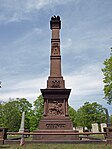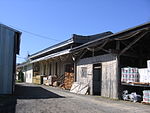West Mountain Historic District

The West Mountain Historic District is a 425-acre (172 ha) historic district northwest of the center of Ridgefield, Connecticut in Fairfield County, Connecticut that was listed on the National Register of Historic Places in 1984. It includes 12 contributing buildings. It is roughly centered on the junction of West Mountain Road and Oreneca Road, between Ridgefield center and the state line. It includes five large country estates developed in the early 20th century. Its "grandest" house is "Orenica", described as "a 1932 Georgian Revival style stone structure of considerable pretension" that was home of Philip Dakin Wagoner (1876-1972), chairman of the board of the Underwood Typewriter Company.: 2, 13
Excerpt from the Wikipedia article West Mountain Historic District (License: CC BY-SA 3.0, Authors, Images).West Mountain Historic District
Old Wagon Road,
Geographical coordinates (GPS) Address Nearby Places Show on map
Geographical coordinates (GPS)
| Latitude | Longitude |
|---|---|
| N 41.298055555556 ° | E -73.528888888889 ° |
Address
Old Wagon Road 34
06877
Connecticut, United States
Open on Google Maps






